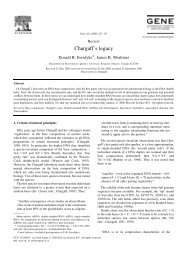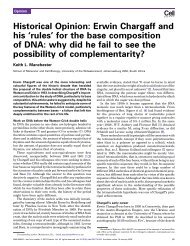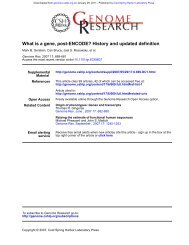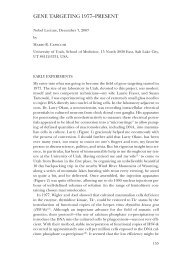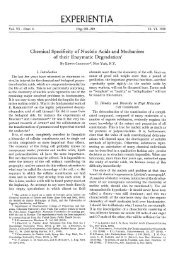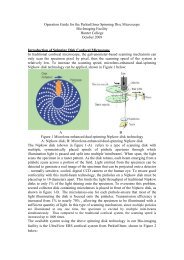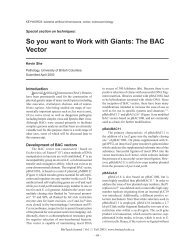Cold Spring Harb Symp Quant Biol-1953-Watson-SQB ... - Biology
Cold Spring Harb Symp Quant Biol-1953-Watson-SQB ... - Biology
Cold Spring Harb Symp Quant Biol-1953-Watson-SQB ... - Biology
Create successful ePaper yourself
Turn your PDF publications into a flip-book with our unique Google optimized e-Paper software.
Downloaded from symposium.cshlp.org on March 26, 2009 - Published by <strong>Cold</strong> <strong>Spring</strong> <strong>Harb</strong>or Laboratory Press<br />
130 ]. D. WATSON AND F. H. C. CRICK<br />
with thymine, and guanine with one of the cytosines.<br />
This specificity results from our assumption<br />
that each of the bases possesses one tautomeric<br />
form which is very much more stable than any of<br />
the other possibilities. The fact that a compound<br />
is tautomeric, however, means that the hydrogen<br />
atoms can occasionally change their locations. It<br />
seems plausible to us that a spontaneous mutation,<br />
which as implied earlier we imagine to be a change<br />
in the sequence of bases, is due to a base occurring<br />
very occasionally in one of the less likely tautomeric<br />
forms, at the moment when the complementary<br />
chain is being formed. For example, while adenine<br />
will normally pair with thymine, if there is a<br />
tautomeric shift of one of its hydrogen atoms it can<br />
pair with cytosine (Figure 7). The next time pairing<br />
occurs, the adenine (having resumed its more<br />
usual tautomeric form) will pair with thymine, but<br />
the cytosine will pair with guanine, and so a change<br />
in the sequence of bases will have occurred. It<br />
would be of interest to know the precise difference<br />
in free energy between the various tautomeric<br />
forms under physiological conditions.<br />
GENERAL CONCLUSION<br />
The proof or disproof of our structure will have<br />
to come from further crystallographic analysis, a<br />
ADENINE<br />
ADENINE<br />
THYMINE<br />
CYT OS INE<br />
FIGURE. 7. Pairing arrangements of adenine before<br />
(above) and after (below) it has undergone a tautomcric<br />
shift.<br />
task we hope will be accomplished soon. It would<br />
be surprising to us, however, if the idea of complementary<br />
chains turns out to be wrong. This<br />
feature was initially postulated by us to account<br />
for the crystallographic regularity and it seems to<br />
us unlikely that its obvious connection with self<br />
replication is a matter of chance. On the other<br />
hand the plectonemic coiling is, superficially at<br />
least, biologically unattractive and so demands precise<br />
crystallographic proof. In any case the evidence<br />
for both the model and the suggested replication<br />
scheme will be strengthened if it can be<br />
shown unambiguously that the genetic specificity is<br />
carried by DNA alone, and, on the molecular side,<br />
how the structure could exert a specific influence<br />
on the cell.<br />
REFERENCES<br />
ASTBURY, W. T., 1947, X-Ray Studies of nucleic acids in<br />
tissues. Sym. Soc. Exp. <strong>Biol</strong>. 1:66-76.<br />
CI-IARGAFF, E., 1951, Structure and function of nucleic acids<br />
as cell constituents. Fed. Proc. 10:654-659.<br />
CRICK, F. H. C., and WATSON, J. D., <strong>1953</strong>, Manuscript in<br />
preparation.<br />
FRANKLIN, R. E., and GOSLING, R., <strong>1953</strong>a, Molecular con.<br />
figuration in sodium thymonucleate. Nature, Lond.<br />
171:740-741.<br />
<strong>1953</strong>b, Fiber diagrams of sodium thymonucleate. I. The<br />
influence of water content. Acta Cryst., Camb. (in<br />
press).<br />
<strong>1953</strong>c, The structure of sodium thymonucleate fibers. II.<br />
The cylindrically symmetrical Patterson Function.<br />
Acta Cryst., Camb. (in press).<br />
FRASER, M. S., and FRASER, R. D. B., 1951, Evidence on<br />
the structure of desoxyribonucleic acid from measurements<br />
with polarized infra-red radiation. Nature,<br />
Lond. 167:760-761.<br />
FRIEDRIcn-FREKSA, H., 1940, Bei der Chromosomen Konjugation<br />
wirksame Krafte und ihre Bedeutung fiir die<br />
identische Verdoppling von Nucleoproteinen. Naturwissenshaften<br />
28:376-379.<br />
GULLAND, J. M., and JORDAN, D. 0., 1946, The macromolecular<br />
behavior of nucleic acids. Sym. Soc. Exp. <strong>Biol</strong>. 1:<br />
56-65.<br />
GULLAND, J. M., JORDAN, D. O., and TAYLOR, H. F. W.,<br />
1947, Electrometric titration of the acidic and basic<br />
groups of the desoxypentose nucleic acid of calf thymus.<br />
J. Chem. Soc. 1131-1141.<br />
HUSKINS, C. L., 1941, The coiling of ehromonemata. <strong>Cold</strong><br />
Spr. <strong>Harb</strong>. <strong>Symp</strong>. <strong>Quant</strong>. <strong>Biol</strong>. 9:13-18.<br />
JORDAN, D. O., 1951, Physiochemical properties of the nucleic<br />
acids. Prog. Biophys. 2:51-89.<br />
KArlLER, H., and LLOYD, B. J., <strong>1953</strong>, The electron microscopy<br />
of sodium desoxyribonucleate. Biochim. Biophys.<br />
Acta 10:355-359.<br />
MANTON, I., 1950, The spiral structure of chromosomes.<br />
<strong>Biol</strong>. Rev. 25:486-508.<br />
MULLER, H. J., 1947, The Gene. Proc. Roy. Soc. Lond. Ser,<br />
B. 134:1-37.<br />
PAULING, L., and DEDBRi3CK, M., 1940, The nature of the<br />
intermolecular forces operative in biological processes.<br />
Science 92:77-79.<br />
SIEGAL, A., and SINGER, S. J., <strong>1953</strong>, The preparation and<br />
properties of desoxypentosenucleic acid. Biochim.<br />
Biophys. Acta 10:311-319.<br />
VILBRANDT, C. F., and TENNENT, n. G., 1943, The effect of



